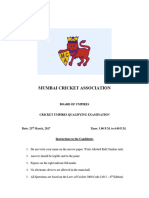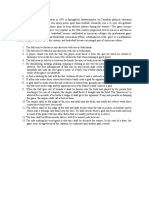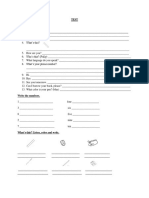0 ratings0% found this document useful (0 votes)
363 viewsDr. James Naismith's Original 13 Rules of Basketball
Dr. James Naismith's Original 13 Rules of Basketball
Uploaded by
Danielle BanDr. James Naismith created the original 13 rules of basketball in 1892, which established the basic guidelines and objectives of the new sport. The rules covered handling of the ball, physical contact, scoring, out of bounds, fouls, roles of the umpire and referee, time limits, and determining a winner. Basketball was invented at Springfield College to provide an indoor game for students to play during the winter.
Copyright:
© All Rights Reserved
Available Formats
Download as DOCX, PDF, TXT or read online from Scribd
Dr. James Naismith's Original 13 Rules of Basketball
Dr. James Naismith's Original 13 Rules of Basketball
Uploaded by
Danielle Ban0 ratings0% found this document useful (0 votes)
363 views1 pageDr. James Naismith created the original 13 rules of basketball in 1892, which established the basic guidelines and objectives of the new sport. The rules covered handling of the ball, physical contact, scoring, out of bounds, fouls, roles of the umpire and referee, time limits, and determining a winner. Basketball was invented at Springfield College to provide an indoor game for students to play during the winter.
Original Description:
A college requirement for PE 4 Team Sports.
Copyright
© © All Rights Reserved
Available Formats
DOCX, PDF, TXT or read online from Scribd
Share this document
Did you find this document useful?
Is this content inappropriate?
Dr. James Naismith created the original 13 rules of basketball in 1892, which established the basic guidelines and objectives of the new sport. The rules covered handling of the ball, physical contact, scoring, out of bounds, fouls, roles of the umpire and referee, time limits, and determining a winner. Basketball was invented at Springfield College to provide an indoor game for students to play during the winter.
Copyright:
© All Rights Reserved
Available Formats
Download as DOCX, PDF, TXT or read online from Scribd
Download as docx, pdf, or txt
0 ratings0% found this document useful (0 votes)
363 views1 pageDr. James Naismith's Original 13 Rules of Basketball
Dr. James Naismith's Original 13 Rules of Basketball
Uploaded by
Danielle BanDr. James Naismith created the original 13 rules of basketball in 1892, which established the basic guidelines and objectives of the new sport. The rules covered handling of the ball, physical contact, scoring, out of bounds, fouls, roles of the umpire and referee, time limits, and determining a winner. Basketball was invented at Springfield College to provide an indoor game for students to play during the winter.
Copyright:
© All Rights Reserved
Available Formats
Download as DOCX, PDF, TXT or read online from Scribd
Download as docx, pdf, or txt
You are on page 1of 1
DR.
JAMES NAISMITH'S ORIGINAL 13 RULES OF BASKETBALL
1. The ball may be thrown in any direction with one or both hands.
2. The ball may be batted in any direction with one or both hands (never with
the fist).
3. A player cannot run with the ball. The player must throw it from the spot on
which he catches it, allowance to be made for a man who catches the ball
when running at a good speed if he tries to stop.
4. The ball must be held in or between the hands; the arms or body must not be
used for holding it.
5. No shouldering, holding, pushing, tripping, or striking in any way the person
of an opponent shall be allowed; the first infringement of this rule by any
player shall count as a foul, the second shall disqualify him until the next
goal is made, or, if there was evident intent to injure the person, for the
whole of the game, no substitute allowed.
6. A foul is striking at the ball with the fist, violation of Rules 3,4, and such as
described in Rule 5.
7. If either side makes three consecutive fouls, it shall count a goal for the
opponents (consecutive means without the opponents in the mean time
making a foul).
8. A goal shall be made when the ball is thrown or batted from the grounds into
the basket and stays there, providing those defending the goal do not touch or
disturb the goal. If the ball rests on the edges, and the opponent moves the
basket, it shall count as a goal.
9. When the ball goes out of bounds, it shall be thrown into the field of play by
the person first touching it. In case of a dispute, the umpire shall throw it
straight into the field. The thrower-in is allowed five seconds; if he holds it
longer, it shall go to the opponent. If any side persists in delaying the game,
the umpire shall call a foul on that side.
10. The umpire shall be judge of the men and shall note the fouls and notify the
referee when three consecutive fouls have been made. He shall have power to
disqualify men according to Rule 5.
11. The referee shall be judge of the ball and shall decide when the ball is in
play, in bounds, to which side it belongs, and shall keep the time. He shall
decide when a goal has been made, and keep account of the goals with any
other duties that are usually performed by a referee.
12. The time shall be two 15-minute halves, with five minutes' rest between.
13. The side making the most goals in that time shall be declared the winner. In
case of a draw, the game may, by agreement of the captains, be continued
until another goal is made.
Note: Basketball was originally two words and these original rules were published
January 15, 1892 in the Springfield College school newspaper, The Triangle.
You might also like
- Telling Stories With Data With Applications in R 9781032134772 9781032133430 9781003229407 2022058452 2022058453 - CompressDocument623 pagesTelling Stories With Data With Applications in R 9781032134772 9781032133430 9781003229407 2022058452 2022058453 - CompressEdu cruz sauñeNo ratings yet
- Advertisement in The Philippines: History, Evolution, and The Filipino ConsumerDocument12 pagesAdvertisement in The Philippines: History, Evolution, and The Filipino ConsumerZeus LegaspiNo ratings yet
- Multiple Choice: Nutrition Exam ReviewerDocument3 pagesMultiple Choice: Nutrition Exam ReviewerDanielle Ban60% (5)
- Violet: Vocal Selections PDFDocument73 pagesViolet: Vocal Selections PDFBrittany Lotshaw4% (25)
- The Rules: Breakthrough Bonus: Download The "Basketball Basics" Article As A FREE PDF! (Document5 pagesThe Rules: Breakthrough Bonus: Download The "Basketball Basics" Article As A FREE PDF! (Cleo VillanuevaNo ratings yet
- Soccer League 2020 Rules & RegulationsDocument2 pagesSoccer League 2020 Rules & RegulationsTinu ThomasNo ratings yet
- Rules of Netball NewDocument2 pagesRules of Netball NewewetNo ratings yet
- Softball BrochureDocument2 pagesSoftball Brochureapi-302159758No ratings yet
- Netball Umpire Hand SignalsDocument2 pagesNetball Umpire Hand Signalsapi-282267269100% (1)
- Volleyball InformationDocument6 pagesVolleyball Informationapi-248122296No ratings yet
- Kanga 8s CricketDocument3 pagesKanga 8s Cricketapi-443327549No ratings yet
- Seven A Side Soccer Rules en 0Document8 pagesSeven A Side Soccer Rules en 0aryolaksono40No ratings yet
- 2017 Eif Rule and InterpretationDocument34 pages2017 Eif Rule and InterpretationJohn KuhneNo ratings yet
- VUW Netball League RulesDocument3 pagesVUW Netball League Rulest_talosagaNo ratings yet
- FPF Rules RegulationsDocument23 pagesFPF Rules RegulationsMatthew MuirheadNo ratings yet
- New Afl RulesDocument7 pagesNew Afl Rulesapi-269614652No ratings yet
- FIELDGAMELAWS 2007 BookletDocument18 pagesFIELDGAMELAWS 2007 Bookletdavid riveraNo ratings yet
- 12 of The Most Confusing Basketball RulesDocument8 pages12 of The Most Confusing Basketball RulesWanttobestronger BeatsNo ratings yet
- Netball RulesDocument3 pagesNetball Rulesapi-201657673No ratings yet
- IFAF RulebookDocument201 pagesIFAF RulebookWilliam DoughertyNo ratings yet
- 3x3 2015 Rules TableDocument1 page3x3 2015 Rules Tableapi-263195650No ratings yet
- Football VocabularyDocument2 pagesFootball VocabularyMałgorzata MajchrzakNo ratings yet
- 2009 Complete NFL RulebookDocument144 pages2009 Complete NFL RulebookAlisa BolanderNo ratings yet
- All About FutsalDocument5 pagesAll About FutsalChristian Salazar100% (1)
- Basketball Handout PDFDocument2 pagesBasketball Handout PDFMarvin Quita100% (1)
- Basketball Referee Part 2 - Questions With Explanations of Answers Latest Update 2024 - 2025Document2 pagesBasketball Referee Part 2 - Questions With Explanations of Answers Latest Update 2024 - 2025decotienoNo ratings yet
- 2024 Playing Rules, Bylaw and Resolution ProposalsDocument45 pages2024 Playing Rules, Bylaw and Resolution ProposalsZennie AbrahamNo ratings yet
- WRHL Rules Updated 1 1 24 2Document19 pagesWRHL Rules Updated 1 1 24 2api-653735011No ratings yet
- Court Dimension of BasketballDocument6 pagesCourt Dimension of BasketballKen SisonNo ratings yet
- HandballDocument21 pagesHandballDeepanshuNo ratings yet
- Football g.9 s.2Document51 pagesFootball g.9 s.2apNo ratings yet
- Violation and FoulsDocument4 pagesViolation and FoulsNerissa ObliagaNo ratings yet
- An Arbiter's Notebook: What Are The Correct Laws of Chess?Document4 pagesAn Arbiter's Notebook: What Are The Correct Laws of Chess?Charles LucasNo ratings yet
- Dodgeball Official RulesDocument2 pagesDodgeball Official Rulesfbi_techNo ratings yet
- Dodgeball Tournament RulesDocument2 pagesDodgeball Tournament Rulesapi-275848882No ratings yet
- Building Up 5 1 Zone DefenceDocument22 pagesBuilding Up 5 1 Zone DefenceMg Mario Ramos TorresNo ratings yet
- Carrom Rules Adi Got 2024Document3 pagesCarrom Rules Adi Got 2024deepakscity18No ratings yet
- Basketball Beginner Rulebook 2018Document25 pagesBasketball Beginner Rulebook 2018api-349011757No ratings yet
- Basketball Exam - Questions With Explanations of Answers Latest Update 2024 - 2025Document15 pagesBasketball Exam - Questions With Explanations of Answers Latest Update 2024 - 2025decotienoNo ratings yet
- MCA - EXAM PAPER - 25 Mar 2017 - English - Ver2Document6 pagesMCA - EXAM PAPER - 25 Mar 2017 - English - Ver2ak19pawarNo ratings yet
- Rules of The Game For HandballDocument18 pagesRules of The Game For HandballAmira LokmanNo ratings yet
- Basketball TermsDocument5 pagesBasketball TermsALVIN DUMASNo ratings yet
- Carrom RulesDocument2 pagesCarrom RulesSubash BasnyatNo ratings yet
- From The Archives..Document3 pagesFrom The Archives..Charles LucasNo ratings yet
- G7 Flag Football RulesDocument12 pagesG7 Flag Football RulesDoug WashingtonNo ratings yet
- 1.2. 5 1 Defence Copenhagen SibilaDocument5 pages1.2. 5 1 Defence Copenhagen SibilaМилан ПанчићNo ratings yet
- DR - James NaismithDocument2 pagesDR - James NaismithJoram PetalunaNo ratings yet
- Playing FloorDocument2 pagesPlaying FloorCj SernaNo ratings yet
- NaismithDocument1 pageNaismithDizon Ropalito P.No ratings yet
- Original RulesDocument1 pageOriginal RulesvhanAileeNo ratings yet
- P.E (Pau)Document8 pagesP.E (Pau)Ezekiel ReyesNo ratings yet
- Rules in BasketballDocument4 pagesRules in BasketballJohnnyboy SalemNo ratings yet
- BasketballDocument1 pageBasketballJK CreationNo ratings yet
- Thirteen Rules of Basketball - James NaismithDocument2 pagesThirteen Rules of Basketball - James NaismithCathy Baysan Olegario CanoNo ratings yet
- Basketball RulesDocument22 pagesBasketball RulesJinley SalvoNo ratings yet
- .Basketball Rules and Regulation.Document30 pages.Basketball Rules and Regulation.Evelyn AbreraNo ratings yet
- Basketball History: Origin of The Sport: 1936 GamesDocument11 pagesBasketball History: Origin of The Sport: 1936 GamesCamille BacaniNo ratings yet
- Above The Sky:: A History of BasketballDocument7 pagesAbove The Sky:: A History of BasketballK.Ariana.WNo ratings yet
- Course Code and Title: Physical Education 114 Course Description: Team SportsDocument32 pagesCourse Code and Title: Physical Education 114 Course Description: Team SportsEarlNo ratings yet
- Marvin Capili Bsba-Om Ii PE4 Assignment (Basketball History)Document7 pagesMarvin Capili Bsba-Om Ii PE4 Assignment (Basketball History)Marvin CapiliNo ratings yet
- P.E. 3 Baskettball Prelim LessonDocument4 pagesP.E. 3 Baskettball Prelim LessonMr.UnknownNo ratings yet
- Basketball RulesDocument10 pagesBasketball RulesNatanim MulualemNo ratings yet
- 20 Time Project PresentationDocument21 pages20 Time Project Presentationapi-308811764No ratings yet
- Georgiana Valentina Radu - 07.12.2021 - My Favourite SportDocument5 pagesGeorgiana Valentina Radu - 07.12.2021 - My Favourite SportGeorgiana RaduNo ratings yet
- Pediatric SeizuresDocument103 pagesPediatric SeizuresDanielle Ban100% (1)
- Leadership and ManagementDocument1 pageLeadership and ManagementDanielle BanNo ratings yet
- Mental Status ExamDocument7 pagesMental Status ExamDanielle BanNo ratings yet
- Bible Technology TriviaDocument2 pagesBible Technology TriviaDanielle BanNo ratings yet
- Case Management Support Plan FormDocument1 pageCase Management Support Plan FormDanielle BanNo ratings yet
- The Lemon in China and ElsewhereDocument18 pagesThe Lemon in China and ElsewhereChen LvNo ratings yet
- Turban Ch1 Ch6Document167 pagesTurban Ch1 Ch6Pramod Khadka100% (4)
- Pages From RFP - DPR - Resort in Sohra - MeghalayaDocument2 pagesPages From RFP - DPR - Resort in Sohra - MeghalayaAnkit kumarNo ratings yet
- 4.final Project ReportDocument52 pages4.final Project ReportShubham Kansal100% (1)
- AMEM Cruise Ships On OrderDocument10 pagesAMEM Cruise Ships On OrderDudu LauraNo ratings yet
- 1 - ch.2 - Natural Setting & Its PeopleDocument2 pages1 - ch.2 - Natural Setting & Its PeoplemadypadNo ratings yet
- Huertas 111Document2 pagesHuertas 111huertascarataoNo ratings yet
- Idoc - Pub Common Food AdulterationDocument17 pagesIdoc - Pub Common Food AdulterationSudarshanNo ratings yet
- Acetaminophen Toxicity: Michira I Getange Umb/15-A/054Document31 pagesAcetaminophen Toxicity: Michira I Getange Umb/15-A/054Ahmed Ben BellaNo ratings yet
- Ultimate Technical Guide Tablet Presses Tooling - EbookDocument41 pagesUltimate Technical Guide Tablet Presses Tooling - EbookVỸ TRẦNNo ratings yet
- Hannah Braime When-Life-WorksDocument5 pagesHannah Braime When-Life-WorksrohishettyNo ratings yet
- CIT University Collegiate Calendar For Academic Year 2012-2013Document4 pagesCIT University Collegiate Calendar For Academic Year 2012-2013Carlo GaliciaNo ratings yet
- In The Name of GodDocument34 pagesIn The Name of GodFariha NormanNo ratings yet
- Provlas OromoDocument26 pagesProvlas OromoSolomon NegashNo ratings yet
- Bank Soal Big KLS 8 PT Citra Aji PratamaDocument33 pagesBank Soal Big KLS 8 PT Citra Aji Pratamabudimir babeahmadNo ratings yet
- Biomolecules Lab ReportDocument8 pagesBiomolecules Lab ReportAshley LinNo ratings yet
- Bake A Chemistry CakeDocument2 pagesBake A Chemistry CakePowerhouse MuseumNo ratings yet
- Brontosaurus Amigurumi PatternDocument9 pagesBrontosaurus Amigurumi PatternAmigurumis Hombre Jengibre100% (1)
- Test Unit 1 and Unit 2Document4 pagesTest Unit 1 and Unit 2bebeulemNo ratings yet
- PhysioEx Exercise 5 Activity 1Document3 pagesPhysioEx Exercise 5 Activity 1villanuevaparedesaracely4No ratings yet
- CBMC Solution 2020-21Document19 pagesCBMC Solution 2020-21Prerna AgrawalNo ratings yet
- ATTACHMENT 1-TECHNICAL BID EVALUATION FOR VALVES ATTACHEMENT AG 1 Rev 1Document4 pagesATTACHMENT 1-TECHNICAL BID EVALUATION FOR VALVES ATTACHEMENT AG 1 Rev 1eko123No ratings yet
- Detailed Lesson Plan in Mathematics 4Document9 pagesDetailed Lesson Plan in Mathematics 4Jay-ar B. Sarate100% (3)
- Social Exchange TheoryDocument35 pagesSocial Exchange TheorynakulpadalkarNo ratings yet
- GET TO THE TOP PLUS - 2 - Key To TestsDocument10 pagesGET TO THE TOP PLUS - 2 - Key To TestsZsolt SzalaiNo ratings yet
- Nursing Care Plan: Davao Doctors College Nursing ProgramDocument1 pageNursing Care Plan: Davao Doctors College Nursing ProgramCrissa KayeNo ratings yet
- Questionnaire Vol.2 Questionaire Survey On Collection and Waste Segregation ProblemDocument4 pagesQuestionnaire Vol.2 Questionaire Survey On Collection and Waste Segregation ProblemGynolderNo ratings yet































































































